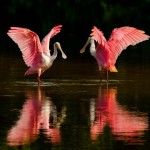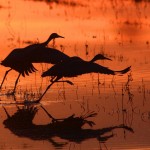From Florida to Michigan, Calif. and Beyond.
Visit Our National Wildlife Refuges
To really explore an area and see birds and animals, you’ll want to get out of your car. But sometimes time is

short, or you want to get the lay of the land before you set out on foot. No problem. Here’s a sampling of some super refuge drives to whet your appetite for the next step.
Choose your own favorites, by wildlife, region or scenery: https://1.usa.gov/19MalqX
Check refuge websites for details. Refuge tour routes are general open sunrise to sunset. Some refuges charge a nominal entrance fee, usually $5.
Bosque del Apache National Wildlife Refuge, New Mexico
An hour from Albuquerque, a 12-mile auto loop along refuge impoundments offers great views of the Chupadera and San Pascual Mountains. From late October through early spring, see huge flocks of sandhill cranes and snow geese fly out at dawn to feed in fields and return at dusk to roost in the marshes. Take the historic route in: El Camino Real National Scenic Byway has connected Mexico City and Santa Fe for hundreds of years.
Wildlife to see: Thousands of sandhill cranes, snow geese, Ross’s geese and ducks.

Lower Klamath and Tule Lake National Wildlife Refuges, California
Separate drives on this pair of northern California refuges feature birds galore and stunning views of Mt. Shasta. Access the 10.2-mile Lower Klamath loop from Stateline Highway 161, 12 miles from the refuge visitor center. An alternative east-side route offers access to a hike along the refuge’s southernmost boundary and seasonal views of sandhill cranes. Pick up the Tule Lake tour route five miles south of the visitor center. Reach both refuges from the Volcanic Legacy All-American Road, a national scenic byway between Oregon’s Crater Lake and California’s Mt. Lassen.
Wildlife to see: Ducks and geese (spring/fall), white pelicans and western grebes (summer, and bald eagles and other raptors (winter). Also, sandhill cranes, tundra swans and many other species.
J.N. “Ding” Darling National Wildlife Refuge, Florida
Four-mile-long Wildlife Drive is slated to reopen in October 2013 after repaving. It’s worth the wait. The Sanibel Island route winds through mangrove forest, cordgrass marsh and hardwood hammocks, offering close-up views of wading birds, shorebirds, seabirds, waterfowl and raptors. Bicycling is also popular on Wildlife Drive, part of the island’s system of multi-use trails.
Wildlife to see: Roseate spoonbills, wood storks, reddish egrets, little blue herons, yellow-crowned night-herons, anhingas, white pelicans, red knots, marbled godwits, bald eagles, otters, bobcats and alligators.
Bombay Hook National Wildlife Refuge, Delaware
A 12-mile wildlife drive cuts across man-made pools, salt marshes, mudflats, woodlands and upland fields. Spring brings migrating waterfowl, wood warblers and shorebirds. Summer draws herons, egrets, avocets, black-necked stilts and terns. Fall and winter months provide resting and wintering grounds for Canada geese, snow geese and a mix of waterfowl. Birds of prey are seen all year long. The drive passes five short walking trails, three with 30-foot-high observation towers.
Wildlife to see: Snow geese, northern pintails, warblers, dunlins, dowitchers, avocets, black-necked stilts, yellow warblers, purple martins, red tailed hawks and bald eagles.
Kenai National Wildlife Refuge, Alaska
Skilak Loop Wildlife Drive, an 18.5-mile gravel loop off the Sterling Highway, leads through a black spruce forest and along Skilak Lake and Engineer Lake, passing several scenic overlooks. Several hiking trails are accessible from the loop.
Wildlife to see: Moose, bear, spruce grouse, snowshoe hares, beaver, lynx, eagles and peregrine falcons.
Wichita Mountains Wildlife Refuge, Oklahoma
Take a three-mile drive to the top of Mt. Scott for a panoramic view of the Wichita Mountain range. Between mountain peaks, see some of country’s last untilled native prairie, where bison and cattle roam among the oaks and greenbriar. Every September the Annual Bison Roundup culls the animals for testing and sale, donation or return to the herd. State Highway 49, which goes about 20 miles through the refuge, is another scenic drive. Both roads are part of the Wichita Mountains National Scenic Byway, as designated by the Federal Highway Administration.
Wildlife to see: Texas Longhorn cattle, bison, elk, deer, coyotes, red-tailed hawks, prairie dogs, turkey, bobcat.
Seney National Wildlife Refuge, Michigan
A seven-mile ride along Marshland Wildlife Drive in this Upper Peninsula refuge leads past wetlands and open water and through deciduous and coniferous forests in the Great Manistique Swamp, an old lumbering area. The road passes three wheelchair-accessible observation decks with viewing scopes. Bicycles are allowed on the auto tour route.
Wildlife to see: Beaver, river otters, bald eagles, osprey, common loons, Canada geese, sandhill cranes, trumpeter swans, black bear, turtles and songbirds.
National Bison Range, Montana
Follow the steep and winding 19-mile gravel road up Red Sleep Mountain for stunning grassland views with herds of bison, antelope, elk, big horn sheep and deer. Trailers and vehicles longer than 30 feet are banned. From the top, see the Mission Mountain range of the Rockies and enjoy panoramic views of Mission Valley. From Red Sleep Mountain Drive, you can also access two short walks.
Wildlife to see: Antelope, elk, mule deer, bison, mountain sheep, eagles.
Ridgefield National Wildlife Refuge, Washington
On the shore of the Lower Columbia River, a 4.2-mile gravel loop road crosses fields, wetlands, sloughs, and forests—easily the refuge’s most popular visitor destination. The auto tour provides a sense of the refuge landscape while making it easy to spy birds and other wildlife, especially at an observation blind.
Wildlife to see: Migrant bird species such as sandhill cranes, as well as resident bird species such as mallards, great blue herons and red-tailed hawks. Coyote, raccoon, skunk, beaver and river otter are occasionally seen.
Des Lacs National Wildlife Refuge, North Dakota
The 19-mile Refuge Backway follows the gently rolling hills of upland prairie, offering excellent views of these and the wooded draws of the Des Lacs Valley, with great scenery and wildlife viewing opportunities. More than 250 species of birds, including waterfowl, raptors and many other migrants, have been seen there, along with deer, moose and other mammals. The Backway also contains the trailhead for Munch’s Coullee National Recreation Trail, a mile-long loop with a universally accessible section; the trailway provides panoramic views and opportunities to see wildlife close-up.
Wildlife to see: Mergansers and snow geese in the spring and fall, several species of grebes in summer, as well as wild turkeys, white-tailed deer and moose.
###
The National Wildlife Refuge System protects wildlife and wildlife habitat on more than 150 million acres of land and water from the Caribbean to the Pacific, Maine to Alaska.
Refuges also improve human health, provide outdoor recreation and support local economies. Visit at https://www.fws.gov/refuges/.